Alan Kay is famously quoted as saying that “the best way to predict the future is to invent it.” I agree. I believe in the power of the imagination and in purposeful innovation to make a positive difference in the world.
Dance of the Two Questions
 A few years ago my wife and I looked at how people invent and innovate. We wrote about what we found in our book Breakthrough. In that book we describe the “Dance of the Two Questions.” The questions are “What is possible?” and “What is needed?” These two questions are partners in the dance of creation. Since then I’ve engaged with others in the lean start-up movement, which has been adding hot new rhythms to this dance.
A few years ago my wife and I looked at how people invent and innovate. We wrote about what we found in our book Breakthrough. In that book we describe the “Dance of the Two Questions.” The questions are “What is possible?” and “What is needed?” These two questions are partners in the dance of creation. Since then I’ve engaged with others in the lean start-up movement, which has been adding hot new rhythms to this dance.
Imagination is a wonderful asset in addressing difficult problems. Working hard without imagination can be a slow and frustrating grind. Imagination helps us to see things differently. It can help us to find a path where none was noticed before. Imagination illuminates what is possible.
Imagination by itself, however, is not enough. It takes more than imagination to plant an idea or invention in the world so that it can thrive and make a difference. Inventions can fail to take root when we create things that nobody needs. There are other failure modes — like lack of patience. An idea may be too early or too late. We may fail to recruit the help we need.
When Innovation Becomes Urgent
We are in a period where invention and innovation are both necessary and possible. The world is changing rapidly and many things seem out of balance. Someone told me recently that a generation is at risk because it is “addicted to distraction.” Another wise friend remarked that tired organizations often have a culture of “learned helplessness.”
Distraction and helplessness are not new and are not unique to any generation or organization. They are failures of imagination and innovation. When they dominate in countries, companies or social organizations, they are signals that things are decaying.
For example, a company that finds itself hobbled by changes in the global economy will not turn things around by continuing business as usual. Changing circumstances demand fresh approaches at all levels of organizations. Helplessness and distraction are not effective ways to meet changing circumstances.
Efficient Customer Development
Increasingly I am becoming an evangelist for customer development — for looking and listening harder about what is needed. This approach is an important contribution from the lean start-up movement. (Brant Cooper and Patrick Vlaskovits’ book The Entrepreneur’s Guide to Customer Development is a very readable introduction). Start-ups have extreme challenges because they cannot afford to build a product, only to discover later that it does not satisfy enough customers. Building a product is expensive.
 In the context of start-ups, the goal is to rapidly identify a customer (and a value proposition and business model) that works. At its heart, customer development is the same as the dictum from design to “fail early and often.” If one approach does not work, customer development does a “pivot” to try something else. Just as rapid prototyping is about efficiently creating new kinds of software, the customer development cycle is about efficiently understanding what is needed.
In the context of start-ups, the goal is to rapidly identify a customer (and a value proposition and business model) that works. At its heart, customer development is the same as the dictum from design to “fail early and often.” If one approach does not work, customer development does a “pivot” to try something else. Just as rapid prototyping is about efficiently creating new kinds of software, the customer development cycle is about efficiently understanding what is needed.
In other situations, other appropriate means need to be found to test whether the product/approach/policy works. The main point is that approaches need to be evaluated and discarded efficiently, mindful of available time and resources. Just as imagination illuminates what is possible, testing the fit of “products” with customers illuminates what is needed. As a case for what is needed becomes clear and compelling, it becomes easier to attract the needed resources and help.
